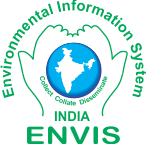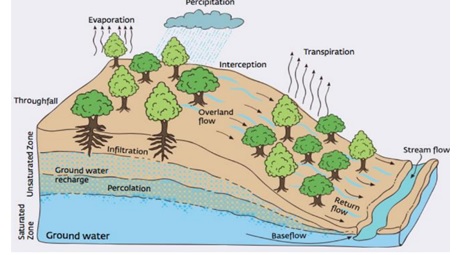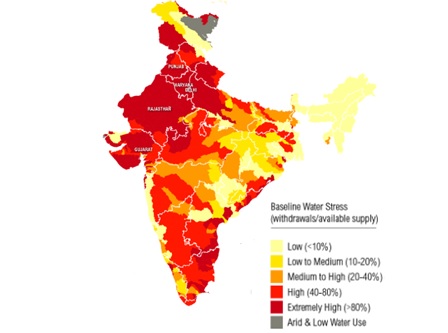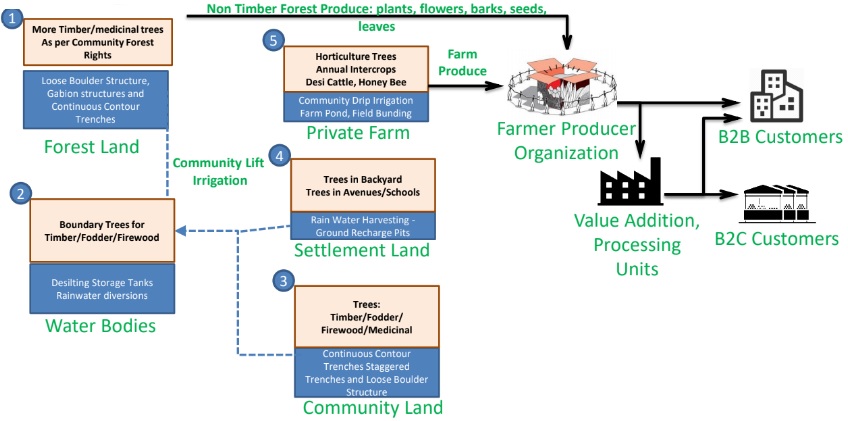 |
Sahyadri ENews: LXIX
HYDRO-ECOLOGICAL FOOTPRINT OF SHARAVATHI RIVER BASIN
|
 |
Issues:
1
2
3
4
5
6
7
8
9
10
11
12
13
14
15
16
17
18
19
20
21
22
23
24
25
26
27
28
29
30
31
32
33
34
35
36
37
38
39
40
41
42
43
44
45
46
47
48
49
50
51
52
53
54
55
56
57
58
59
60
61
62
63
64
65
66
67
68
RALLY FOR RIVERS: A MODEL FOR REVITALISATION OF INDIAN RIVERS
(PDF)
Rajesh Anand Ethirajalu1 and Vishwesh Singh2
1Project Director ,Rally for Rivers,Isha Foundation, Coimbatore
2Volunteer ,Rally for Rivers,Isha Foundation, Coimbatore
E-mail: vishwesh.singh@rallyforrivers.org; mob:+91-9669841567
web: https://isha.sadhguru.org/rally-for-rivers/
SYNOPSIS
Major Indian Rivers have depleted dramatically in just a few decades and many are gradually dying. We need large-scale interventions to protect and revitalize them. Agriculture is a major sector consuming river water and is the major rural economic activity, but associated risks are increasing due to climate change, water shortage, increasing input costs and lower returns, while intensification of agriculture is depleting and polluting rivers.
We propose an economic model for sustainable agriculture with beneficial ecological consequences for rivers. It is proposed to take `village-as-watershed’ as a unit of implementation and a target stretch of at least 60 to 100 km as a pilot initiative in each state which can then be scaled up to enhance vegetative cover in both public and private riparian lands across the respective states. Farmland interventions can multiply farmer incomes at least 3 to 5 times and community forestry can provide income from sustainable harvesting of NTFPs. We aim to reduce agricultural water-use through agro-horti-forestry and micro-irrigation. A robust institution and strong economic incentive are achieved via Farmer Producer Organisations (FPOs) which process the produce and create sustained market linkages. Scaling up requires policy changes, government budgetary support and people’s participation.
INTRODUCTION: OUR DYING RIVERS
Indian rivers have been severely affected due to a combination of direct and indirect impacts of human activities. Many major perennial rivers are shrinking and becoming seasonal while minor river systems are vanishing. River Godavari has shrunk by almost 20% from historical flows, Kaveri has shrunk by 40%, while Krishna and Narmada have shrunk by 60%. Today we only have a fourth of the per capita water availability as compared to 1947 and 25% of our land is undergoing desertification .
These rivers are homes to bio-diversity and are the birthplaces of the first human civilizations, and as such have assumed the identity of “life givers”. Even today rivers meet one-third of the total irrigation and twenty per cent of the drinking water needs of the country. Their value needs to be recognized and they need to be protected. It has to be ensured that every river has full ecological flows and its health in terms of biological, chemical and physical characteristics of its water has to be protected.
=> Deteriorating Water Security:
Today 54% of the country faces HIGH to EXTREMELY HIGH water stress and the situation is getting worse with declining per capita availability of water. 22 out of 32 major Indian cities deal with daily water shortage and it is projected that we will only have 50% of the water needed for survival by 2030. There is a higher incidence of floods due to deforestation and leading to desertification of land as excessive soil is eroded and organic content is not replenished in the absence of trees. Groundwater decline, exacerbated by water-intensive crops like paddy and sugarcane, poses a threat to over 60% of the irrigated area that depends on it. Agriculture is the largest consumer of freshwater at 90% of total withdrawal. Not only are rivers getting over-exploited but the issue is further worsened by unchecked pollution in the form of untreated sewage, agricultural runoff with chemicals and industrial effluent
RIVER REVITALIZATION
There is an urgent need to conserve and revitalize our rivers, the efforts for which need to be guided by robust science and with the utilization of appropriate technologies. These rivers have been central to our longstanding cultural heritage and there is a need to treat them as a national treasure. A river needs to have two characteristics if it has to be considered ‘living’: aviral dhara or continuous unfettered flow and nirmal dhara or unpolluted flow, and it must be an ecological and geological entity across the basin in all seasons. Many of our rivers are losing or have lost these characteristics and there is a need for planned scientific efforts to be made if they are to be revitalized.
=> Riverside Afforestation:
Afforestation of riverside lands offers a solution to the pressing problem of dying rivers. The proposed solution is to have tree cover for a minimum of one kilometer on either side of the rivers beyond the 25 year flood-plain. This will be achieved by tree plantation on both public and private lands on riversides. Public land will have native and endemic tree species while private farm lands will have organic tree-based agriculture instead of water intensive seasonal crops.
=> Working Principle:
Riverside afforestation works on the principle that roots of trees penetrating deep into the ground facilitate infiltration of rainwater. This water is absorbed into the subsurface instead of flowing over land which leads to floods and erosion. This water infiltrates the soil and percolates to deeper levels adding to the groundwater and slowly transfers into the stream via base flows sustaining steady flows over a longer time period. A point which is often overlooked is the effect of trees in increasing of total precipitation. The intermittent presence of trees that grow up to a height of 40 feet in any part of land ends up causing repeated rainfall in the local region. Compression of wind blowing at the forest edge produces more water vapour and cools ascending air forming Ekman Spirals. These spirals cause repeated rainfall in the local region. These upward spirals carry insect, pollen and bacteria from trees and these act as nuclei for condensation and rain. The condensation effect created by tree foliage adds substantial amount of water harvested from the humidity in the environment.
=> Recommendations
The Rally for Rivers recommendations for river revitalization relate to three primary impact areas:
1. Increase Water Inflow – By creating green cover on either side of the river for a minimum of one kilometre beyond the river’s 25 year flood mark.
2. Sustainable Groundwater and Surface Water Usage to Increase Base Flows to Rivers – By reducing agricultural water usage via micro-irrigation and tree based agriculture.
3. Ensuring Pollution-free Water Flow – By tackling urban sewage, agricultural chemical run-offs and industrial effluents.
The key objective is to increase inflows into rivers and the means to this are re-vegetation through reforestation and agro-forestry. Recognising the value of floodplains in groundwater recharge through base flows, villages in floodplains are proposed to be taken up in the initiative. With the ‘village-as-watershed’ as a unit of implementation and a target stretch of at least 60 to 100 kilometer in a river, the program aims to enhance vegetative cover for river-revitalisation through (i) soil and water conservation measures, (ii) revival of native riparian vegetation up to the 25-year flood mark, (iii) reforestation on riverside forest land, (iv) increased tree cover in private farmlands of riparian villages, and (v) conversion of flood irrigation to micro-irrigation. If the land is under shade, the organic material in the soil can build up. Only then will the soil retain water and allow it to percolate.
The recommendations have been formed keeping in mind the different scenarios, challenges and opportunities in Private Farmlands and Public Lands:
PRIVATE FARMLAND
The increased tree cover in private farmlands of riparian villages can happen by inspiring and guiding farmers to shift a part of the land away from water intensive seasonal crops to organic tree based agriculture with the support of government departments.
The strategy is to bring about this transition is by a people’s movement on the ground and policy interventions at the top. The underlying economic model doubles the farmers’ income. This incentive will encourage them to shift from crop based The strategy is to bring about this transition is by a people’s movement on the ground and policy interventions at the top. The underlying economic model doubles the farmers’ income. This incentive will encourage them to shift from crop based
Agro-Horti-Forestry Model
The agro-horti-forestry model envisaged, aims to simulate a forest-like condition which is the recommended approach for greening of flood plains. This also improves agricultural water-use efficiency. Generic agro-forestry models will be created that will be location specific, they will contain multiple fruit species ensuring poly-culture, multi-purpose trees on east-west borders as alley crops, mulch, herbal trees on north-south border as shrubs and for bio-inputs. Fodder crops on boundaries and native livestock will be required to secure soil fertility without chemical use. Agro-horti-forestry also requires less labour and time, freeing up to two-thirds of the farmer’s time which may be utilized to create allied livelihoods to stabilize and diversify agricultural income.
Such a shift from seasonal crops to agro-horti-forestry has already been successfully implemented in various areas of Maharashtra. Andhra Pradesh government has also announced plans to shift to transition 6 million farms/farmers cultivating 8 million hectares of land from conventional synthetic chemical agriculture to Zero-Budget Natural Farming (ZBNF) by 2024 .
Agro-horti-forestry also has the added benefit that lands that are not productive right now due to problems such as lack of labour, high cost of cultivation or suffering due to scarcity of water and climate fluctuations, can be brought under cultivation with this model as it translates into reduced labour requirements, cost of cultivation, water requirement for irrigation and improved climate resilience. These lands will be brought under timber tree plantations with short, medium and long gestation timber trees and will add to the farmer’s assets and income flows, insulating his family from economic shocks, while also protecting forests from exploitation for timber. In 2016, India was the third largest importer of illegally logged wood. India’s annual import of logs and wood products has increased to $2.7 billion , this indicates the high demand which if met with domestic production means reduced stress on India’s foreign reserves, increased income for farmers and a sustainable supply of raw material to India’s wood-based industries.
=> Micro-irrigation
Micro-irrigation has been proven effective in reducing water consumption, improving water use efficiency by 50% as compared to flood irrigation, and also increasing yield of produce in horticulture plantations by 20-40%. To augment the source of water, micro-irrigation is an important intervention that prudently manages the water demand. Wherever possible Community Micro-irrigation projects will also be undertaken which further increases water use efficiency and brings down the overall costs.
This will mean a reduction in the groundwater consumption and reduced need for additional bore-well capital costs and the resultant debt on farmers.
=> Enabling Policy Framework
The farmers need to be supported in this transition by appropriate policy interventions. Their notional loss of income in transitioning to horticulture due to the time taken until there is a commercial yield needs to be compensated. This should be viewed as an investment in securing the farmer’s future and will be hugely beneficial to the rural economy. This compensation can be provided on a per tree survival basis. The funding required for the transition should be facilitated through existing schemes / programs or financial institution/banks, in the form of low interest or zero interest loans. Further insurance for crops and livestock should be made mandatory.
Once the trees start yielding, the farmers need a hassle-free and economical way to certify their organic produce. This can be done by facilitating group certification of the farm and produce. Additionally native livestock ownership should be facilitated by the government if required for this transition to organic farming.
The farmer’s produce needs guaranteed off-take by private sector and private infrastructure such as cold storage, value-addition processing units and allied industries, for which investments are required upfront from the industrial sector and NABARD. This will happen in tandem with behaviour change interventions at consumer level to promote fruits as healthy alternatives and bringing fruits into school midday meals and anganwadis as children’s health initiative. The MSP regime needs to be updated with MSP only as a floor price.
FPOs will have to be created to aggregate produce and increase the bargaining power for farmers to ensure best price realisation. Collective investment is also facilitated in supply of inputs, micro-irrigation, quality control, grading, storage, processing, value-addition, marketing, branding, cold-chain and transportation. Farmers can reap the benefits of economies of scale without losing control over their produce or land through the institution of FPOs.
Another major area of focus for the success of these interventions is planting material quality. The farmers will need to be provided high quality planting material and the appropriate expertise during the transition to ensure economic gains.
A coordinated institutional functioning is required to support the activities happening in each project region. An appropriate nodal agency can be formed at the national and state levels. Aspects that need to be addressed are (a) single window support system for a given farmer (b) ICT support like dashboard for monitoring progress (c) permanent program implementing team for at least 10 years (d) a robust management and monitoring plan and (e) convergence across various government departments/agencies.
PUBLIC LAND
On government owned lands: forests, commons and revenue lands, endemic forest trees should be planted that also create economic opportunities for traditional forest-dwelling communities. The implementation should ensure community participation and cooperation for greater benefit for the local communities and for protection and conservation of the forests. This is keeping in view that the Forest Rights Act provides for Community Forest Resource Management Rights to these communities allowing ecologically sustainable harvest of Non-Timber Forest Produce. Sustainable harvest in conjunction with facilitation of buy-back arrangements with traders and industries will ensure long-term benefit to the communities from the forests.
Participation of local communities will be ensured via mass public awareness campaigns and involving them in the process through school-based nurseries (Green School Movement) and youth clubs.
HOLISTIC END-TO-END APPROACH
The Rally for Rivers model takes a holistic approach to river revitalization recognizing the role of communities and economics in bringing about large-scale ecological development. The end-to-end solution where economics drives ecology is illustrated in Figure 3.
Figure 3 shows the economic and ecological links between the different project components. The economic links connect the horticultural produce from private farmlands and NTFP from forest land to the end-users via FPO in raw and value added forms. The formation of FPOs is critical to realization of economic gains by the communities involved enabling them to reap the benefits from aggregation, value addition and improved market access. The ecological links show how appropriate soil and water conservation interventions in the various project components replenish the soil and the water bodies in the region, thereby revitalising the natural foundations on which remunerative productive activities take place.
 Figure 3 Physical process through which trees contribute to increased base flow in rivers. Source: Rally for Rivers Draft Policy Recommendations
=> Market Development via FPOs
Figure 3 Physical process through which trees contribute to increased base flow in rivers. Source: Rally for Rivers Draft Policy Recommendations
=> Market Development via FPOs
Two major factors are required for the success of the program (a) a robust institution and (b) a strong economic incentive. For this, it is proposed to establish a FPO. The FPO plays a vital role in the model enabling the farmers and forest-dwelling communities to improve their incomes. Aggregation of input procurement, sales, value addition activities and marketing becomes possible if farmers are organized via FPO.
Aggregation of produce translates into greater negotiating power and creates a possibility for strong and beneficial market linkages through strategic tie-ups with end-user companies. The aggregation of produce on a large scale (25,000+ farmers) also creates an opportunity for investments in value addition infrastructure and branding.
=> Soil and Water Conservation
The soil and water conservation measures will be appropriate to the region and the land utilization, the strategic groundwater recharge zones will be identified considering the hydrological regime. On farmlands interventions such as farm boundary bunding protected by border trees are proposed to prevent surface run-off. Additionally creation of water storage structures like farm ponds on landholdings above 1 hectare are proposed. In settlement areas rain water harvesting implementation with construction of recharge pits in each household is recommended. For community lands continuous contour trenching and staggered trenching to increase percolation of surface water and loose boulder structures to prevent stream widening and arrest soil erosion, and lastly in forest areas in addition to trenching and loose boulder
KEY OUTCOMES
The Detailed Project Report for the pilot project in Maharashtra, to plant 60 lakh trees with an 80% survival rate, has been submitted to the State Government. The projected benefits created in first five years of Rally for Rivers interventions with an investment of Rs. 985.34 crore in the project region are:
• Year 1: Rs. 195.02 crore
• Year 2: Rs. 190.13 crore
• Year 3: Rs. 284.16 crore
• Year 4: Rs. 269.90 crore
• Year 5: Rs. 46.13 crore
Project Rate of Return: 27% p.a. in 15 years.
=> Long-term Impact - Post 20 River Revitalization Projects
If 20 River Revitalisation projects are undertaken on major rivers, the long-term impacts for the nation are three-fold: Environmental, Social and Economic benefits.
Environmental Benefits – Large scale afforestation on riversides will make rivers perennial, enhance water availability, recharge groundwater and improve rainfall patterns. Further the planting of trees will mean CO2 reduction of 140 million tons p.a. (6% of Nationally Determined Goal of creating a carbon sink of 2.5 to 3 billion tonnes of CO2 by 2030 ). 4 million hectares of land will be brought structures it will be beneficial to construct gabion structures to protect stream embankments, reduce soil erosion by trapping silt and preserving the water harvesting capacity of downstream structures by preventing siltation. In strategic groundwater recharge zones, interventions for percolation can be undertaken like artificial recharge wells, percolation tanks, bhungroo etc.
=> Yavatmal Project – Government of Maharashtra
under green cover which will support biodiversity and improve water and soil quality.
Social Benefits – The impact of these interventions on the communities is more than purely economic benefit. Farmer incomes will increase 5-7 times in the project areas directly benefitting 26 lakh farmers. There will be a reduction in calamities like flood and drought due to the moderating influence of green cover on riversides. Horticulture produce with farmers will also mean better nutrition security and healthier lifestyles, for the farmers and the nation.
Economic Benefits – The economic benefits created due to plantations on public and private land will boost rural economy by 1% of the national GDP.
RALLY FOR RIVERS - THE RALLY AND UPCOMING PROJECTS
Rally for Rivers was initiated by Sadhguru, founder of Isha Foundation, as a 30-day nation-wide awareness campaigns with 146 events in 16 states in September 2017. The Rally saw participation of 162 million people and 16 Chief Ministers from across the political spectrum. The Rally brought together people from diverse backgrounds for the cause of saving India’s lifelines. It culminated in Delhi where the Draft Policy Recommendations for Revitalization of Indian Rivers was submitted to the Prime Minister. An expert group was constituted under CEO of NITI Aayog and 6 Union Ministries to study the draft. This resulted in an advisory being sent to all the States encouraging them to take up river revitalization projects based on the draft: ‘Draft Program of Action for River Rejuvenation using MNREGS’ prepared by Ministry of Rural Development.
Currently 6 states have signed MoUs with Isha Foundation, namely: Maharashtra, Karnataka, Punjab, Gujarat, Chhattisgarh and Assam. The first pilot project is set to start in Yavatmal, Maharashtra after Rally for Rivers submitted its Detailed Project Report. Assisted forest regeneration through plantation drives and seeding, and a mass agroforestry initiative is planned for in Karnataka in 2019.
 Figure 1 Baseline Water Stress in India (withdrawals/available supply) Source: World Resources Institute
Figure 1 Baseline Water Stress in India (withdrawals/available supply) Source: World Resources Institute
 Figure 2 Project Components
Figure 2 Project Components




